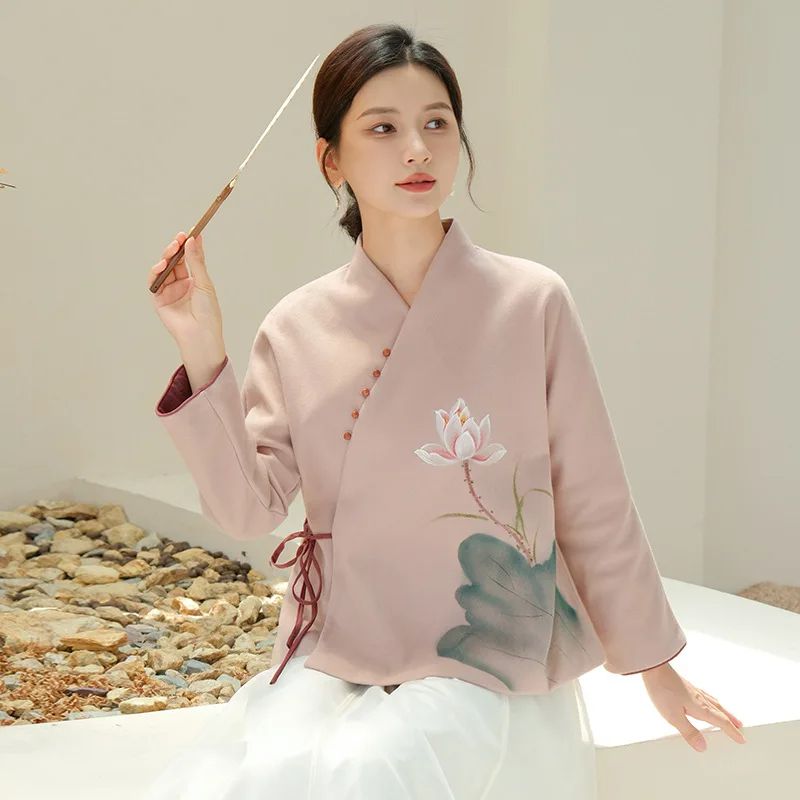Hanfu‘s Embrace of Gender Fluidity: A Historical Perspective
A Platform for Gender Fluidity
Modern hanfu, the revival of pakaian tradisional Tiongkok, has emerged as a platform for gender fluidity, challenging societal norms and embracing a more inclusive understanding of identity. Historically, hanfu was strictly gendered, with distinct styles and colors assigned to men and women. However, contemporary interpretations of hanfu have shattered these boundaries, allowing individuals to express their gender identities freely.

The Shift Towards Gender Fluidity
This shift towards gender fluidity in hanfu can be traced back to the early 2000s, when a growing number of individuals began experimenting with wearing hanfu that defied traditional gender norms. Inspired by historical records and artistic depictions, they created androgynous styles that blurred the lines between masculine and feminine. This movement gained momentum through online communities and social media, where individuals shared their experiences and encouraged others to embrace their true selves.
Support and Resistance
The embrace of gender fluidity in hanfu has been met with both support and resistance. Some traditionalists argue that hanfu should remain rooted in its historical context, while others celebrate the evolution of the garmen as a reflection of modern society’s changing attitudes towards gender. This debate has sparked discussions about the nature of tradition, the role of pakaian in shaping identity, and the importance of inclusivity in cultural practices.
Cultural Pride and Heritage
Beyond its impact on gender expression, modern hanfu has also become a symbol of cultural pride and heritage. By reclaiming and reinterpreting this traditional garment, individuals are not only challenging gender norms but also connecting with their Chinese roots. Hanfu has become a way for people to express their cultural identity while simultaneously embracing their unique perspectives on gender.
Catalyst for Conversations
The fluidity of hanfu extends beyond its physical form. It has also become a catalyst for conversations about gender equality and the need for a more inclusive society. By breaking down traditional gender roles, hanfu empowers individuals to define their own identities and challenge societal expectations. It serves as a reminder that clothing is not merely a covering but a powerful tool for self-expression and social change.
Kesimpulan
In conclusion, modern hanfu has become a vibrant and dynamic platform for gender fluidity, challenging historical norms and embracing a more inclusive understanding of identity. Through its androgynous styles and its connection to cultural heritage, hanfu has empowered individuals to express their true selves while simultaneously fostering discussions about gender equality and the importance of inclusivity in society. As the movement continues to evolve, hanfu will undoubtedly remain a powerful symbol of both cultural pride and personal liberation.
Hanfu modern as a Platform for Gender Expression
Challenging Societal Norms
Modern hanfu, a revival of traditional Chinese clothing, has emerged as a platform for gender fluidity, challenging societal norms and empowering individuals to express their identities. This movement has its roots in the growing acceptance of gender diversity and the desire to break free from restrictive gender roles.

Reimagining Traditional Styles
Hanfu, with its intricate designs and flowing silhouettes, has historically been associated with specific genders. However, contemporary designers are reimagining these garments, blurring the lines between masculine and feminine. By incorporating elements from both traditional male and female hanfu, they create pieces that transcend gender boundaries.
Empowerment for Non-Binary Identities
This fluidity extends beyond the physical realm. Hanfu has become a symbol of self-expression and empowerment for individuals who identify as non-binary, genderqueer, or transgender. By wearing hanfu that defies traditional gender norms, they challenge societal expectations and assert their right to exist outside of binary categories.
Supportive Community
Moreover, the hanfu community has fostered a supportive and inclusive environment where individuals can explore their gender identities without judgment. Online forums and social media groups provide a space for sharing experiences, discussing gender-related issues, and connecting with others who share similar perspectives.
Cultural Conversations
The modern hanfu movement has also sparked conversations about the fluidity of gender in Chinese culture. Historically, gender roles in China have been relatively rigid, but the revival of hanfu has opened up new possibilities for self-expression and challenged traditional notions of masculinity and femininity.
Lasting Impact
As the hanfu movement continues to grow, it is likely to have a lasting impact on Chinese society. By breaking down gender boundaries in traditional clothing, it empowers individuals to embrace their true selves and fosters a more inclusive and accepting environment for all.
The Intersection of Modern Hanfu and LGBTQ+ Identity
A Powerful Force for Change
Modern hanfu, the revival of traditional Chinese clothing, has emerged as a powerful force in challenging gender norms and promoting inclusivity within the LGBTQ+ community. Historically, hanfu was strictly gendered, with distinct styles and colors assigned to men and women. However, contemporary designers are breaking these boundaries, creating gender-fluid hanfu that allows individuals to express their identities freely.

Embracing Gender Diversity
This shift towards gender fluidity in hanfu is driven by a growing awareness of the diversity of gender expression within the LGBTQ+ community. Traditional gender roles and expectations have often marginalized non-binary and genderqueer individuals, but modern hanfu offers a space for them to embrace their true selves. By blurring the lines between masculine and feminine styles, gender-fluid hanfu empowers individuals to defy societal norms and celebrate their unique identities.
Building Community
Moreover, the revival of hanfu has fostered a sense of community and belonging among LGBTQ+ individuals. Through online forums and social media groups, they connect with others who share their passion for hanfu and their experiences of gender fluidity. These platforms provide a safe and supportive space for individuals to explore their identities and find acceptance within the broader hanfu community.
Challenging Traditional Notions
The intersection of hanfu and LGBTQ+ identity has also sparked important conversations about the fluidity of gender in Chinese culture. Historically, Chinese society has emphasized the importance of binary gender roles, but the emergence of gender-fluid hanfu challenges these traditional notions. By embracing diversity and inclusivity, modern hanfu is contributing to a broader cultural shift towards greater acceptance of LGBTQ+ identities.
Impact on the Fashion Industry
Furthermore, the popularity of gender-fluid hanfu has had a ripple effect on the fashion industry as a whole. It has inspired designers to rethink traditional gendered clothing categories and create more inclusive and expressive designs. This trend towards gender fluidity in fashion reflects a growing societal recognition of the importance of self-expression and the right of individuals to define their own identities.
Kesimpulan
In conclusion, modern hanfu has become a powerful symbol of gender fluidity and inclusivity within the LGBTQ+ community. By breaking down traditional gender boundaries and fostering a sense of community, gender-fluid hanfu empowers individuals to embrace their true selves and challenge societal norms. Its impact extends beyond the realm of fashion, contributing to a broader cultural shift towards greater acceptance and understanding of gender diversity.
